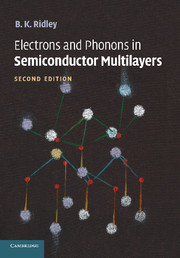Book contents
- Frontmatter
- Contents
- Preface
- Introduction
- 1 Simple Models of the Electron–Phonon Interaction
- 2 Quantum Confinement of Carriers
- 3 Quasi-Continuum Theory of Lattice Vibrations
- 4 Bulk Vibrational Modes in an Isotropic Continuum
- 5 Optical Modes in a Quantum Well
- 6 Superlattice Modes
- 7 Optical Modes in Various Structures
- 8 Electron–Optical Phonon Interaction in a Quantum Well
- 9 Other Scattering Mechanisms
- 10 Quantum Screening
- 11 The Electron Distribution Function
- 12 Spin Relaxation
- 13 Electrons and Phonons in the Wurtzite Lattice
- 14 Nitride Heterostructures
- 15 Terahertz Sources
- Appendix 1 The Polar-Optical Momentum-Relaxation Time in a 2D Degenerate Gas
- Appendix 2 Electron/Polar Optical Phonon Scattering Rates in a Spherical Cosine Band
- References
- Index
3 - Quasi-Continuum Theory of Lattice Vibrations
Published online by Cambridge University Press: 05 September 2009
- Frontmatter
- Contents
- Preface
- Introduction
- 1 Simple Models of the Electron–Phonon Interaction
- 2 Quantum Confinement of Carriers
- 3 Quasi-Continuum Theory of Lattice Vibrations
- 4 Bulk Vibrational Modes in an Isotropic Continuum
- 5 Optical Modes in a Quantum Well
- 6 Superlattice Modes
- 7 Optical Modes in Various Structures
- 8 Electron–Optical Phonon Interaction in a Quantum Well
- 9 Other Scattering Mechanisms
- 10 Quantum Screening
- 11 The Electron Distribution Function
- 12 Spin Relaxation
- 13 Electrons and Phonons in the Wurtzite Lattice
- 14 Nitride Heterostructures
- 15 Terahertz Sources
- Appendix 1 The Polar-Optical Momentum-Relaxation Time in a 2D Degenerate Gas
- Appendix 2 Electron/Polar Optical Phonon Scattering Rates in a Spherical Cosine Band
- References
- Index
Summary
…a dim and undetermined sense Of unknown modes …
The Prelude, W. WordsworthIntroduction
We now turn to the problem of describing long-wavelength lattice vibrations in multilayered structures. At a microstructural level this problem is solved by using the techniques of lattice dynamics requiring intense numerical computation. This approach is inconvenient, if not impracticable, at the macroscopic level, where the kinetics and dynamics of large numbers of particles need to be described. In this theoretical regime it is necessary to obtain models that transcend those at the level of individual atoms in order to describe electron and hole scattering, and all the energy and momentum relaxation processes that underlie transport and optical properties of macroscopic structures. The basic problem is to make a bridge between the atomic crystal lattice and the classical continuum. We know from the theory of elasticity and the theory of acoustic waves, which hark back to the nineteenth century, that continuum theory works extremely well for long-wave acoustic waves. The case of optical vibrations is another matter. Here, the essence is one atom vibrating against another in a primitive unit cell and it is by no means obvious that a continuum approach can work in this case. This has been highlighted by controversy concerning the boundary conditions that long-wave optical vibrations obey at each interface of a multilayer structure.
- Type
- Chapter
- Information
- Electrons and Phonons in Semiconductor Multilayers , pp. 67 - 96Publisher: Cambridge University PressPrint publication year: 2009

